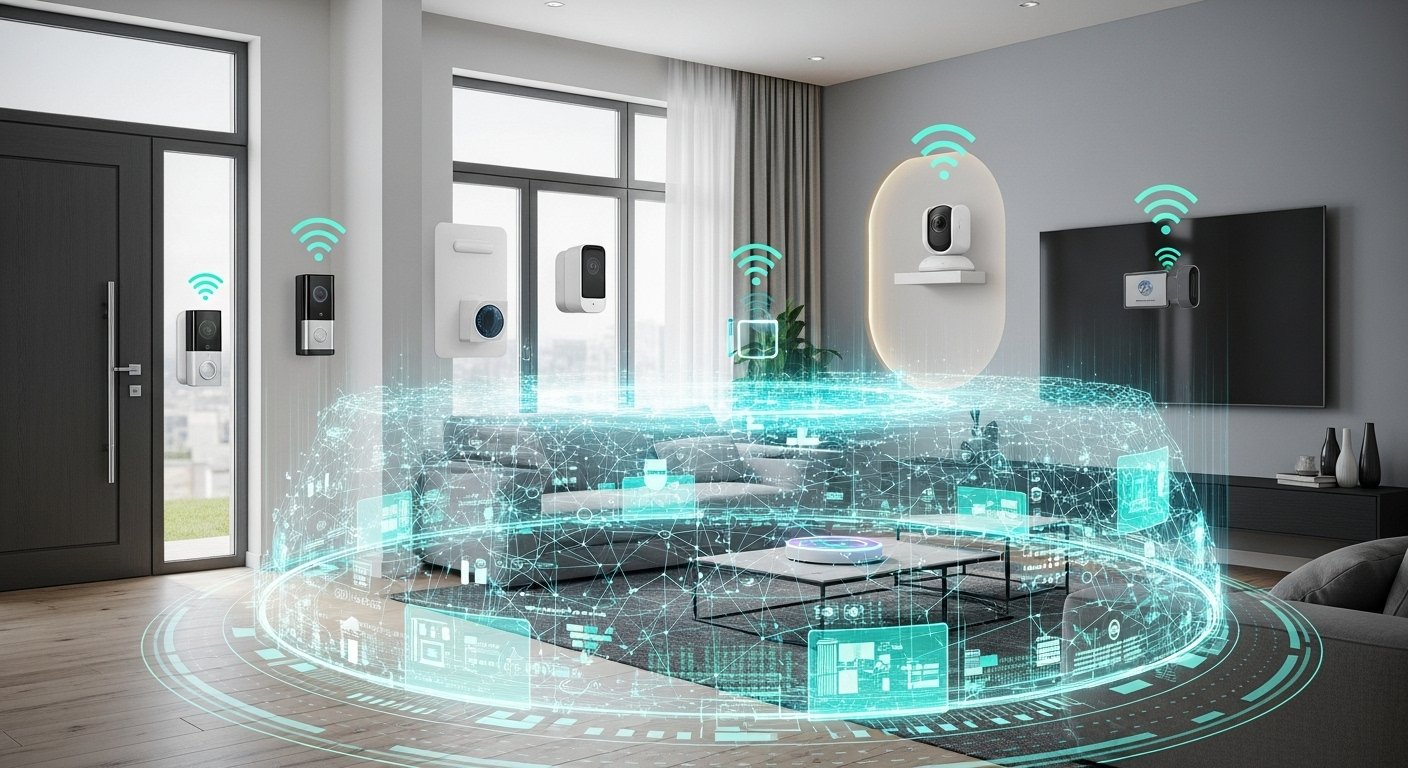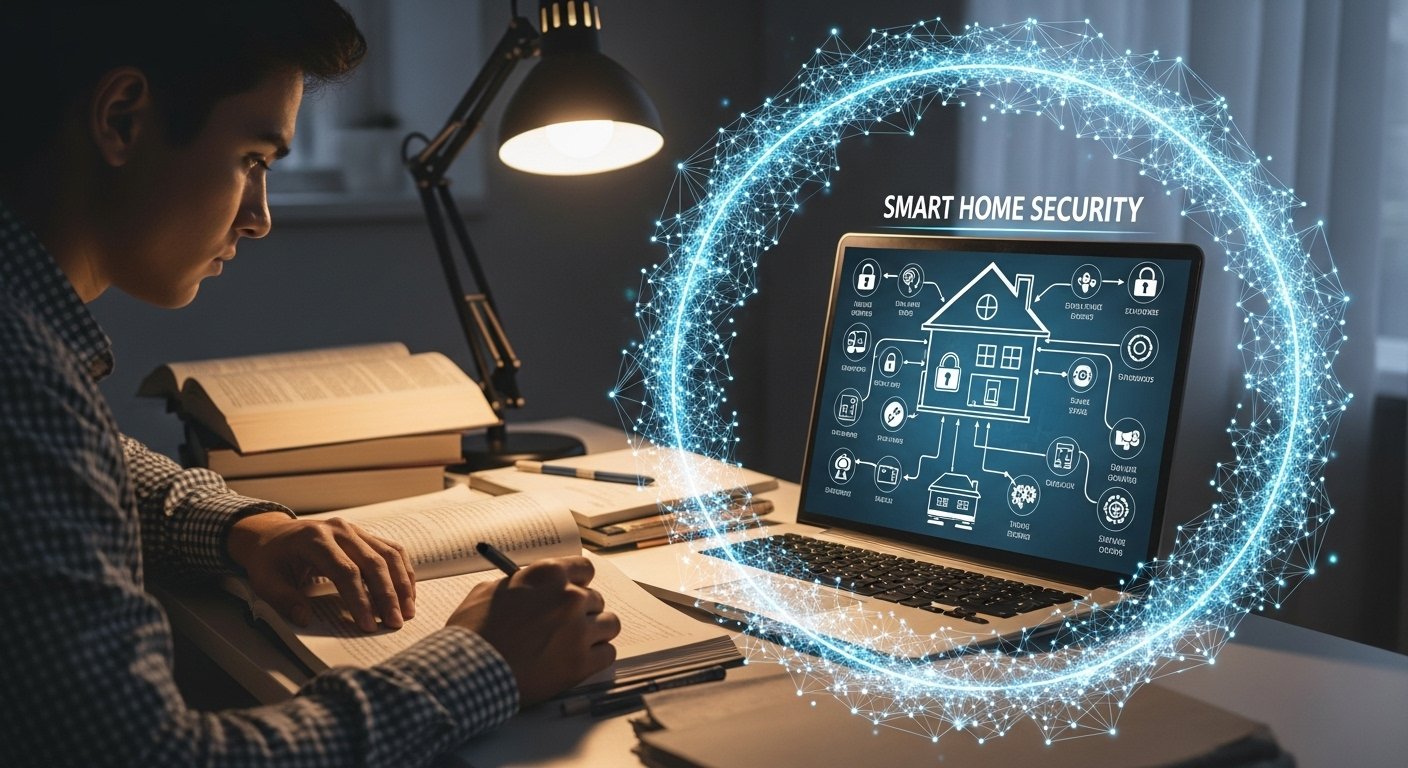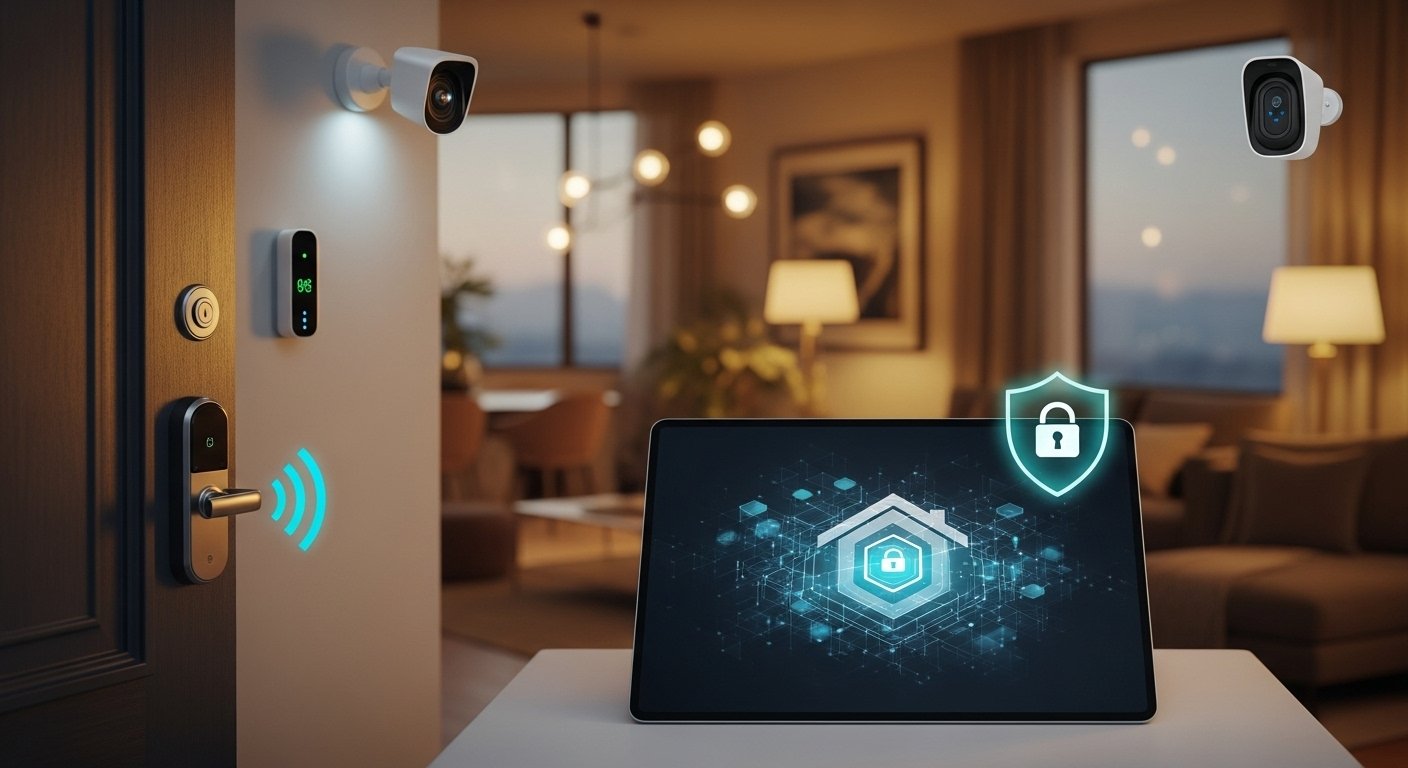The convenience offered by smart home automation is undeniable, transforming everyday living with interconnected devices. However, this growing connectivity also introduces significant challenges, particularly regarding smart home security. As students of technology and future innovators, understanding how to safeguard these intelligent environments is paramount. A robust smart home security system isn’t just about deterring intruders; it’s about protecting your digital privacy, your data, and your peace of mind in an increasingly connected world. This comprehensive guide will equip you with 9 essential strategies to fortify your smart home, turning potential vulnerabilities into bulletproof defenses.

What is a Smart Home Security System?
AAt its core, a smart home security system is an integrated network of devices and software designed to protect your home and its occupants through automation and remote management. These systems move beyond traditional home alarm systems by leveraging the Internet of Things (IoT) to provide enhanced monitoring, control, and responsiveness. Key components often include `security cameras`, `smart locks`, `motion sensors`, `smart doorbells`, and `integrated alarm systems`, all working in concert to create a vigilant perimeter and interior defense. Control is typically managed via a central hub, a smartphone app, or even through `Voice Assistants` like Alexa or Google Assistant. [16]
Smart home security systems offer various levels of protection, ranging from self-monitored setups, where homeowners receive alerts and take action themselves, to professionally monitored services. With professional monitoring, a third-party company actively oversees your home’s security and can dispatch emergency services in response to alarms. This hybrid approach allows for flexibility, catering to different needs and budgets, and often incorporates advanced features like `remote home monitoring` and `real-time alerts`.
The Evolving Landscape of Smart Home Security Vulnerabilities
While the promise of a smart home is alluring, it’s crucial to acknowledge the inherent `smart home security vulnerabilities` that come with increased connectivity. The security risks of smart home devices are escalating rapidly. Recent data indicates a alarming trend: attacks on smart home products surged by a staggering 124% in 2024. [7] This dramatic increase underscores the growing interest from malicious actors in exploiting the weakest links in our digital lives. A significant majority, 99.3%, of these smart home attacks exploit common vulnerabilities and exposures (CVEs), highlighting the importance of basic security hygiene.
Beyond direct attacks, privacy concerns loom large. A substantial 57% of Americans are concerned about how their data is collected and used by smart devices, and 46% fear potential hacking of their smart home systems. [15] These fears are not unfounded; in 2024–2025, a reported 9% of smart homes experienced at least one cyber breach attempt. Alarmingly, 82% of consumer IoT devices lack proper access controls or password protection in 2025, creating wide-open doors for potential exploitation. [10]
So, what are the most vulnerable smart home devices? Research suggests that common culprits include smart TVs, smart plugs, routers, and IP cameras. Smart TVs, in particular, accounted for 34% of cybersecurity vulnerabilities in smart home systems, often due to their extended lifespans and manufacturers discontinuing software support while devices are still in use. Routers also stand out, possessing the second most known vulnerabilities at 24%, followed by IP cameras at 12%. [10] Understanding these weak points is the first step towards building a more resilient and secure smart home.

9 Ways to Bulletproof Your Smart Home Security
To truly bulletproof your connected living space, a multi-layered approach to `cybersecurity for smart homes` is essential. Here are nine critical strategies:
1. Fortify Your Smart Home Network Security
Your home’s Wi-Fi network is the backbone of your smart home, making its security paramount. Start by changing the default administrator credentials on your router immediately upon installation. Always use strong, unique passwords for your Wi-Fi network, combining uppercase and lowercase letters, numbers, and symbols. Employ WPA3 encryption if your router supports it, as it offers superior protection compared to older standards. Consider creating a separate guest network for visitors and less critical smart home security devices, isolating them from your primary network and sensitive data. Regularly check your router’s firmware for updates, as manufacturers frequently release patches for known vulnerabilities. For a deeper dive into how smart homes function and how to optimize your network, consider this resource: How Does Smart Home Work? A Comprehensive Guide.
2. Implement Strong Authentication and Access Controls
Weak credentials are an open invitation for hackers. For every smart home device, from `smart locks` to `security cameras smart home` systems, use unique, complex passwords. Avoid common phrases or personal information. The most effective defense against unauthorized access is enabling `Two-Factor Authentication` (2FA) wherever possible. This adds an extra layer of security, typically requiring a code from your phone in addition to your password, making it significantly harder for attackers to gain entry even if they compromise your password. For physical access, smart locks with biometric scanners (fingerprint recognition) can add an extra layer of convenience and security.
3. Prioritize Secure Smart Home Security Devices
When investing in `smart home security devices`, choose reputable brands known for their commitment to security and privacy. Research potential purchases thoroughly, looking for devices that offer strong encryption, regular security updates, and clear privacy policies. Read reviews that specifically address security aspects (related search: “smart home security systems reviews”). Essential devices like `wireless security cameras`, advanced `smart locks`, and responsive `motion sensors` should be evaluated based on their security features, not just their convenience or price. Integrating a `smart doorbell` with two-way audio and video capabilities can provide an excellent first line of defense. To help you get started with selecting secure and essential devices, explore our guide on Home Automation for Beginners: 5 Must-Have Smart Home Devices.
4. Keep Software and Firmware Updated
Outdated software is a primary `smart home security vulnerability`. Manufacturers continuously release firmware and software updates to patch discovered security flaws and enhance device performance. Make it a habit to regularly check for and install these updates on all your smart home devices, including your router, smart hub, cameras, and even smart appliances. Many devices offer automatic updates, which should be enabled if available. Neglecting updates leaves your devices susceptible to exploits that 99.3% of smart home attacks leverage. [1]
5. Understand and Manage Data Privacy for Smart Homes
Smart home devices collect vast amounts of data, from your daily routines captured by `security cameras` to your voice commands processed by `Voice Assistants`. As 57% of Americans are concerned about data collection and use, taking proactive steps to protect your privacy is crucial. [15] Carefully review the privacy policies of all your `smart home security devices` and services. Understand what data is being collected, how it’s used, and with whom it’s shared. Opt-out of unnecessary data sharing or telemetry whenever possible. Regularly delete old recordings or data that is no longer needed, if your device allows it. Consider the implications of connecting new devices to your `smart home automation systems` and how they might impact your overall privacy posture.
6. Embrace Integrated Alarm Systems and Professional Monitoring
For comprehensive protection, consider `integrated alarm systems` that tie together your `smart locks`, `security cameras`, and `motion sensors` into a unified platform. These `home alarm systems` can be either self-monitored or professionally monitored. While `DIY home security` systems offer flexibility and often no monthly fees, professional monitoring provides an added layer of vigilance. Companies offering professional monitoring services typically have 24/7 centers that respond to alarms, verifying threats and dispatching emergency services like police or fire departments. This can be invaluable, especially when you are away from home. The choice between self-monitored or professionally monitored depends on your comfort level, budget, and the level of protection you desire, addressing both commercial investigation and informational intent.
7. Strategically Place Security Cameras and Motion Sensors
Effective placement of `wireless security cameras` and `motion sensors` is vital for optimal security coverage. Strategically position cameras to monitor entry points, high-value areas, and blind spots around your property. Ensure that cameras provide clear views and are not easily obstructed. For `security cameras smart home` integration, choose models that offer `video surveillance`, `motion detection`, and `real-time alerts` to your smartphone. Similarly, `motion sensors` should be placed in areas where an intruder would likely pass, such as hallways or near windows. For outdoor use, select cameras with weatherproofing and night vision capabilities for year-round `remote home monitoring`.
8. Secure Voice Assistants and Smart Home Automation Systems
`Voice Assistants` like Alexa and Google Assistant are convenient, but they also present potential security challenges. Review their privacy settings diligently. Restrict access to sensitive functions, disable voice purchasing if not needed, and be mindful of what you say in their presence. For your broader `smart home automation systems`, regularly audit connected devices and their permissions. Remove any devices you no longer use or that have questionable security track records. Ensure that your smart home hub itself is updated and protected with strong credentials, as it acts as the central brain for many of your `smart home security devices`.
9. Plan for Power Outages and Network Disruptions
What happens to smart home security during a power outage or internet disruption? A robust security plan accounts for these scenarios. Many `home security systems` and `smart home security devices` come with battery backups to maintain functionality during power loss. For internet outages, look for systems that offer cellular backup. This ensures that your `integrated alarm systems` can still communicate with monitoring centers or send you alerts, even when your Wi-Fi is down. This redundancy is critical for maintaining continuous protection and peace of mind.

Choosing the Right Smart Home Security System: Key Considerations
Selecting the `best smart home security systems` involves weighing several factors beyond just the devices themselves. Your decision will likely involve a mix of commercial investigation and informational understanding.
DIY vs. Professional Installation: Many `smart home security systems` offer `DIY installation`, providing flexibility and often lower upfront `equipment costs`. This is appealing for those comfortable with technology. However, professionally installed systems guarantee expert setup and often come with more robust `professional monitoring` options.
Monitoring Options: Decide whether you prefer `DIY home security` with self-monitoring and `no monthly fee`, or a professionally monitored service that includes `monthly fees` but offers 24/7 vigilance and emergency dispatch. Both have their `smart home security pros and cons`.
Integration and Compatibility: Consider how well the system integrates with other `smart home services` and existing devices. Compatibility with `Alexa integration`, `Google Assistant compatibility`, and other `home automation` platforms is a key feature for many users. Look into `smart home automation systems` that offer seamless connectivity for all your devices.
Advanced Features: Evaluate features like `AI security systems`, which can offer advanced analytics for `video surveillance` and `motion detection`, reducing false alarms. Also, consider the availability of `smart doorbell` cameras, environmental sensors (smoke, CO), and `smart locks` with advanced functionalities.
Privacy and Data Handling: Revisit the data privacy discussion. Investigate the `smart home security companies’` policies on data collection, storage, and sharing. Transparency in these areas is crucial.
For a structured approach to planning your smart home and its security, refer to this useful resource: Your Smart Home Automation Checklist: A Planning Guide.
The Future of Smart Home Security: AI and Advanced Protections
The landscape of `smart home security` is continually evolving. The integration of `AI security systems` is poised to revolutionize how we protect our homes, offering more intelligent detection, predictive analytics, and personalized security responses. As technology advances, we can expect even more sophisticated `smart home security features` that adapt to our behaviors and anticipate potential threats, moving towards truly proactive protection. The ongoing focus on `cybersecurity for smart homes` will drive innovation, making our connected environments safer and more resilient against emerging `smart home security vulnerabilities`.
Conclusion
Smart home automation brings unparalleled convenience, but it also demands a proactive and informed approach to security. By understanding the potential `smart home security vulnerabilities` and implementing these nine strategies, from strengthening your `smart home network security` to choosing secure `smart home security devices` and maintaining rigorous software updates, you can significantly enhance the protection of your connected living space. The goal is not just to react to threats, but to anticipate and prevent them, ensuring your smart home remains a sanctuary of comfort and safety.

Leave a Reply